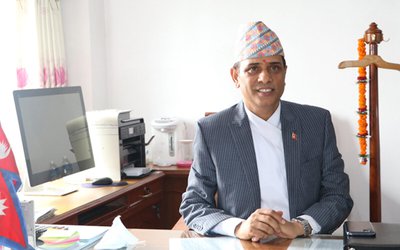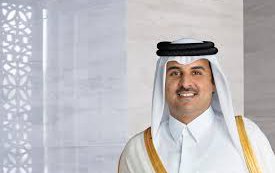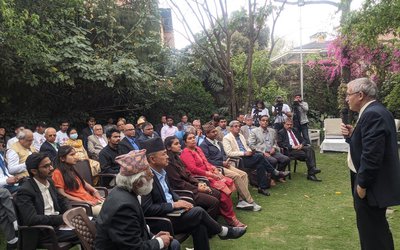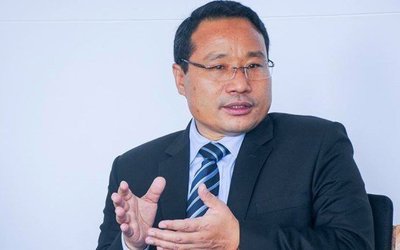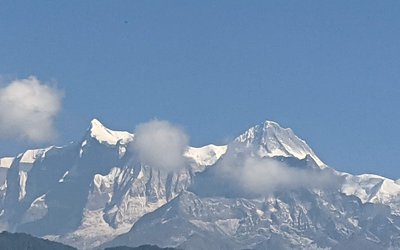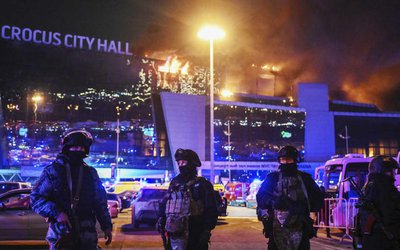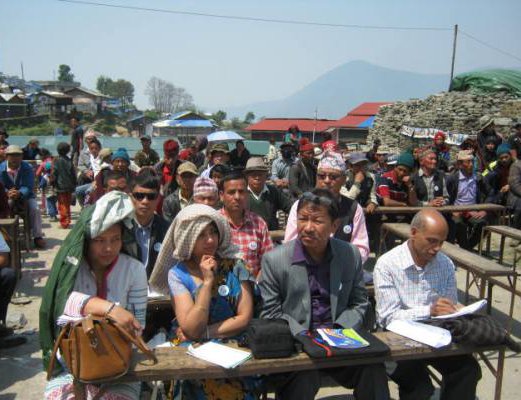
Although the spring was a time in Barpak to be enthralled by the musical notes of the lark bird, the sounds of stone quarries and construction sites have drowned it out for this year.
Masons and other construction workers march to the building construction sites early in the morning and generate the typical sounds of their instruments, cutting stone, wood and iron.
A year after the great earthquake, Barpak, the epicenter, is gradually recovering from the trauma and shock. Although the people are coming to terms slowly and gradually, life is coming back to normal.
In the changing atmosphere, four organizations, Humanitarian Accountability Monitoring Initiative (HAMI), Himalayan Conservation Group (HCG), Community Self-Reliant Centre (CSRC), Nepal Community Development Monitoring Centre (NCDMC) and OXFAM Nepal organized the Barpak Conference to bring up the issues of reconstruction in public sphere.
Participated in by local community leaders, politicians, Members of Legislature Parliament, representatives of NGOs and INGOs, officials of Gorkha district and experts, the Barpak Conference concluded by adopting an 11-point Barpak Declaration.
“This is the time to review what we have done and what we need to do to effectively carry out the reconstruction work,” said Rabindra Adhikary, chairman of the Development Committee of the Legislature Parliament. “We, the members of the parliament, fully agree with the Barpak Declaration.”
Along with Adhikary, other Members of Parliament Ram Narayan Bidari, Cham Bahadur Gurung UCPN-Maoist and Ranjana Sarkar of CPN-UML and Jeevan Pariyar and Badri Pandey of Nepali Congress have also expressed their solidarity to reconstruct and revive Barpak.
At a time when a large number of people are still living in temporary shelters without hope for building new homes soon, the Barpak Conference has revived their hope as different stakeholders have expressed solidarity to accelerate the reconstruction work.
“Of course, the process of reconstruction started late, I want to assure you all that the process of distribution of grant will move fast now,” said Sharmila Karki, member of National Reconstruction Authority. “Residents of Barpak will receive the grant money soon.”
The lackluster performance of National Reconstruction Authority, gender sensitivity and exclusion of Dalits were also raised prominently as issues at the Conference. “NRA should carefully handle the issues of exclusion of particular communities and groups in the reconstruction of Barpak,” said Bimal Gadal from OXFAM.
Story of Settlement
Although President Vidya Bhandari launched the distribution of the first installment of Rs. 200,000.00 in grants to the victims, just a day before the Barpak Conference of April 25, Bhesh Bahadur Bishwokarma, 55, a Dalit from Barpak Village Development Committee, does not know where he can build his house. His old land was declared unusable.
Along with thar of Bhesh Bahadur, forty houses in a Dalit settlement of Barpak were destroyed by the earthquake and the land has cracked in several places. Although president Bhandari launched the distribution of first installment from the same Dalit settlement on April 24, they don’t know where to use the money to reconstruct the houses.
“We are living in temporary shelters constructed in the public land. We need land as well as money,” said Kisan Ram BK, who has been surviving on his traditional profession as iron smith. Father of four children, Kisan Ram’s new settlement is uncertain along with that of other 40 households of his community.
Dominated by British and Indian Army pensioners, the settlement is known for discriminating against women in the distribution of relief.
“In the process of reconstruction, gender perspective should be given a higher priority. Women should be given an equal opportunity in the distribution of the grant money,” said former member of National Planning Commission Dr. Bimala Poudyal Rai.
Women victims said that the process of distribution of money is not gender responsive. “VDCs denied recommending us as victims eligible for grant on the ground that my mother does not hold any land certificate. Since my father is out of the country and he is not coming anytime soon, what can we do?” asked Pushpa Ghale. “There is discrimination in wages among male and female members. Only males are given training as masons. Are not we eligible?” asked Ghale.
As six parliamentarians, representing three major political parties, political leaders, civil society leaders, human rights activities, dalit activists, development experts and district based administrators, representatives of NGOs and INGOs jointly passed the 11-point Barpak Declaration, calling for the need to accelerate reconstruction, this gave people like BK and Pushpa Ghale a reason to rejoice.
Barkpak Conference was the first such interaction organized to bring all stakeholders together to discuss the earthquake reconstruction, relocation and other issues of house grant, loan, and implementation of integrated urban plan.
Along with the MPs, the chief district officer, Police, Nepal Army and representatives from National Reconstruction Authority and political leaders interacted with over 500 local community members on various agenda of reconstruction.
“The visit of president and inauguration of Barpak Earthquake Memorial Park has injected new hope among the people. The Barpak Conference helped us to listen to the grievances of people and other stakeholders for the revival of the area,” said Chief District Officer Narayan Prasad Adhikary.
Facilitated by General Secretary, Humanitarian Accountability Monitoring Initiative (HAMI) Dr. Padma Prasad Khatiwada, the Barpak Conference was a two-way interaction between local community and different stakeholders.
“As President Bhandari visited here a day before and a declaration was made, our hope to reconstruct Barpak in the old style has been revived. I don’t know how long will it take to materialize the assurance of the president and this declaration but I can say that somebody is listening to us,” said Man Bahadur Ghale, member of Nepali Congress, of the Village Development Committee.
Dalit Activist Ganesh BK said that Dalit communities faced a huge damage compared to other communities. "There is the need to give a special attention to Dalits of Barpak,” said Ganesh BK.
Along with 40 local settlements of Dalits, 273 houses need to be relocated in Barpak. As the government has already allocated a new forest land to them for temporary settlement, the decision is yet to be taken on the permanent settlement.
Out of 1447 households destroyed by the earthquake, 1412 house owners have received red stickers who are eligible for the grant. “As the process of distribution of grant has already started, it needs to be further accelerated. If the process moves in the present way, it will take decades to complete the task,” said Dr. Balkrishna Mabuhang.
Gautam Gurung of Barpak, Ward No 1, has also lost the house and piece of land and is waiting to get grants for reconstruction. “The victims with financial capability have already started reconstruction of their houses and many of them have already built theirs. However, over 80 percent of people are living in an uncertain situation. As the process of distributing money is so lengthy and complicated, it is almost certain that we have to live in the temporary shelter in coming summer also,” said Gurung.
Nepal last week marked the first anniversary of its most brutal natural disaster in decades. The April 25 earthquake and its aftershocks killed nearly 9,000 people and injured over 22,000 others. Villages were flattened, and priceless monuments reduced to rubble. According to the National Reconstruction Authority, 591,000 households will receive home rebuilding grants for the part of the groundwork.
The government wants to ensure that it hands out cash only to those whose homes were truly wrecked by the quakes, and that those with multiple properties don’t get to “double-dip.”
A year on, reconstruction is far behind schedule. Political infighting kept a dedicated reconstruction authority from starting its work promptly. And for months beginning last fall, protests against a new constitution disrupted imports of fuel and other essentials from neighboring India.
“Nothing is happening. The process is so lengthy and complicated. Looking at the government’s inaction, Barpak’s population has started their reconstruction mission on their own,” said Bir Bahaduar Ghale, head of Micro-Hydro Management Committee. “Reviving the life, maintenance of micro-hydro completed, the power supply has already resumed. The supply of electricity injected new hope in Barpak.”
Explaining the complication in the process of receiving grants and loans, secretary of Barpak Village Development Committee Chet Prasad Amgai held the view that there is the need to reduce the lengthy paper work. “Instead of distributing money through bank account, people should be given cash, inspecting the stages of the construction work,” said Amgai. “Without simplification of the process, the VDC secretary cannot do anything alone.”
Foreign governments and development groups pledged $4.1 billion in aid, but getting it to those in need is proving difficult. The National Reconstruction Authority has initiated programs on both fronts. But it only this month started to distribute money for rebuilding to homeowners in certain areas. Tendering has started for just a handful of new schools.
Four million people still live in substandard temporary shelters, according to the International Federation of Red Cross and Red Crescent Societies. More than 800,000 houses were damaged fully or partially by the earthquake, according to the Red Cross and the Nepal government.
With the call for revival in the epicenter, Barpak, the message of Barpak Conference is that there is the need to accelerate the process of reconstruction so that people can move to their permanent settlement again.
Reporting from Barpak

Keshab Poudel
Poudel is the editor of New Spotlight Magazine.
- CLA: Samriddhi For Skill Development
- Apr 23, 2024
- ECONOMY: Growth At 3.3
- Apr 16, 2024
- DPM’s SHRESTHA’S CHINA VISIT High Profile, Low Key
- Apr 14, 2024
- Maha Kumbha In Barahkshetra: A Sacred Festival In Sacred Koshi (Kaushiki) River
- Apr 09, 2024
- LOSS AND DAMAGE: Upper Tamakoshi A Case
- Apr 02, 2024


